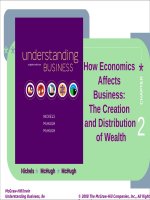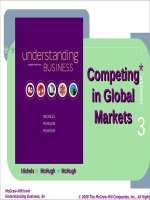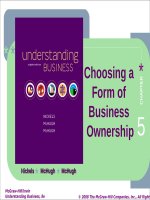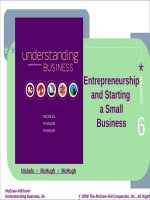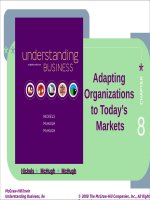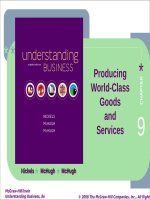Understanding business 11th by mchugh nickels chap020
Bạn đang xem bản rút gọn của tài liệu. Xem và tải ngay bản đầy đủ của tài liệu tại đây (982.17 KB, 40 trang )
CHAPTER 20
Money,
Financial
Institutions,
and the Federal
Reserve
McGraw-Hill/Irwin
Copyright © 2015 by the McGraw-Hill Companies, Inc. All rights reserved.
LEARNING OBJECTIVES
1. Explain what money is and what makes money
useful.
2. Describe how the Federal Reserve controls the
money supply.
3. Trace the history of banking and the Federal
Reserve System.
4. Classify the various institutions in the U.S. banking
system.
20-2
LEARNING OBJECTIVES
5. Briefly trace the causes of the banking crisis, and
explain how the government protects your funds
during such crises.
6. Describe how technology helps make banking more
efficient.
7. Evaluate the role and importance of international
banking, the World Bank, and the International
Monetary Fund.
20-3
JANET YELLEN
Federal Reserve
• The first female chair of the
Federal Reserve.
• Earned her doctorate in
economics from Yale and
was appointed to the Federal
Reserve Board of Governors
by President Clinton.
• Almost every factor related to
the economy is influenced by
the decisions she makes.
20-4
NAME that COMPANY
This company recently opened an online store using
a new form of money.
Name that company and what currency it uses!
20-5
WHAT’S MONEY?
LO 20-1
• Money -- Anything people generally accept as
payment for goods and services.
• Barter -- The direct trading of
goods or services for other
goods or services.
20-6
STANDARDS for a
USEFUL FORM of MONEY
LO 20-1
• Portability
• Divisibility
• Stability
• Durability
• Uniqueness
20-7
The BITCOIN is in the MAIL
• Bitcoin is a digital currency
created in 2008.
• It is attractive to many users
because there is no central
regulating authority.
• Transactions are between only
two people without middlemen.
• This, however, makes valuing
Bitcoin difficult.
20-8
The MONEY SUPPLY
LO 20-2
• Money Supply -- The amount of money the Federal
Reserve makes available for people. The money
supply is referred to as:
- M1 -- Money that can be accessed quickly (coins,
paper money, travelers’ checks, etc.).
- M2 -- M1 + money that may take a little time to
obtain (savings accounts, mutual funds, etc.).
- M3 -- M2 + big deposits like institutional money
market funds.
20-9
NEW MONEY
LO 20-2
Paper Money Printed in 2010 (In $ Billions)
Source: Bloomberg Businessweek, www.businessweek.com, accessed November 2014.
20-10
HOW LONG DOES
PAPER MONEY LAST?
Source: Federal Reserve, www.federalreserve.gov, accessed November 2014.
LO 20-2
20-11
MONEY MILESTONES
LO 20-2
20-12
MONEY FACTS
LO 20-2
What You Might Not Know About What’s in Your Wallet
• In 2009, the U.S. printed 26,000,000 bills a day!
• Each penny costs 1.6¢ and each nickel costs 6¢
to make.
• The most-tracked bill on WheresGeorge.com has
travelled over 4,100 miles in 3 years!
• 2/3 of all U.S. $100 bills are outside the U.S.
• 90% of paper money has traces of cocaine!
Source: Fast Company, wwww.fastcompany.com, accessed November 2014.
20-13
EXCHANGING MONEY GLOBALLY
LO 20-2
• Falling dollar value: The amount of goods and
services you can buy with a dollar decreases.
• Rising dollar value: The amount of goods and
services you can buy with a dollar increases.
• What makes the dollar fall or rise is the position of
the U.S. economy relative to other global
economies.
20-14
The IMPACT of a
FALLING DOLLAR
LO 20-2
• Overseas demand for U.S. products rise.
• A favorable exchange rate for U.S. companies
increases profits in foreign markets.
• U.S. tourism increases
which is good for hotels,
resorts, theme parks, and
retailers that serve
international travelers.
20-15
FIVE MAJOR PARTS of the
FEDERAL RESERVE SYSTEM
LO 20-2
1. The Board of Governors
2. The Federal Open
Market Committee
3. 12 Federal Reserve
Banks
4. 3 Advisory Councils
5. The member banks of
the system
20-16
The 12 FEDERAL RESERVE
DISTRICT BANKS
LO 20-2
20-17
MANAGING the MONEY SUPPLY
LO 20-2
20-18
CHECK-CLEARING PROCESS
THROUGH the FEDERAL RESERVE
LO 20-2
20-19
TEST PREP
• What is money?
• What are the five characteristics of useful money?
• What is Bitcoin?
• What is the money supply, and why is it important?
• How does the Federal Reserve control the money
supply?
• What are the major functions of the Federal
Reserve? What other functions does it perform?
20-20
The ESTABLISHMENT of the
FEDERAL RESERVE SYSTEM
LO 20-3
• A cash shortage problem in 1907 led to the
creation of the Federal Reserve System.
• Under the Federal
Reserve Act of 1913,
all federally chartered
banks had to join the
Federal Reserve.
20-21
LARGEST BANK FAILURES
Source: FDIC.gov, accessed November 2014.
LO 20-3
20-22
The U.S. BANKING SYSTEM
LO 20-4
• Commercial banks
• Savings and loan
associations
• Credit unions
• Nonbanks
20-23
COMMERCIAL BANKS
LO 20-4
• Commercial Bank -- A profit-seeking organization
that receives deposits from individuals and
corporations in the form of checking and savings
accounts and uses those funds to make loans.
• A commercial bank has two types of customers:
1. Depositors
2. Borrowers
20-24
COMMERICAL BANKS’
SERVICES
LO 20-4
• Demand Deposit -- The technical name for a
checking account; money is available on demand
from the depositor.
• Time Deposit -- A savings account; a bank can
require a prior notice before you make a withdrawal.
• Certificate of Deposit -- A savings account that
earns interest, to be delivered on the certificate’s
maturity date.
20-25

